How to Stop Goggles From Fogging Up
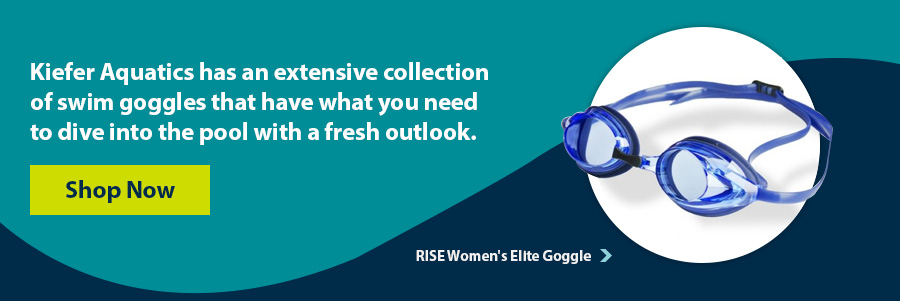
Swim Tips, Swim Goggles
|
October 24, 2022
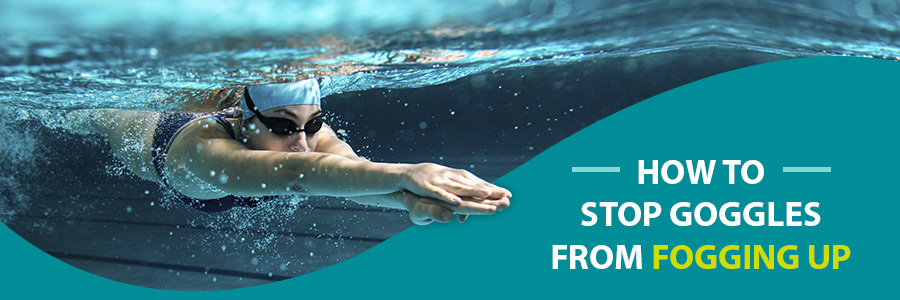
How to Stop Goggles From Fogging Up
Swimming is an intense, competitive sport. Athletes dedicate countless hours, both in and out of the pool, to improving their time. You set goals for yourself, work with your coach and hone your technique in hopes it will all pay off on race day. When that day finally comes, you feel nervous but prepared. All you need to do is focus on your stroke. The buzzer goes off, and you hit the water — but then your goggles fog up, and your focus is instantly shattered. All swimmers know the importance of good gear, and foggy goggles are a common challenge for all swimmers. While this issue might be annoying on a practice day, it can mean the difference between victory or defeat on race day. How do you stop your goggles from fogging up? First, you need to know what is causing the problem, and then you can learn how to prevent it. Shop Swim GogglesWhy Are Your Swimming Goggles Fogging Up?
The human eye is not designed for underwater vision. Goggles allow you to see underwater while you practice and race. You can see where you are going, stay in your lane and focus on your technique. Fog defeats the purpose of goggles. You can't reach up and wipe the fog from your goggles, either, because it forms inside the lenses. At best, you feel distracted. At worst, you start to swim off-course. You may even need to stop mid-stroke to take off your goggles and clear them — but why does fog happen in the first place? Condensation is the culprit behind foggy goggles. Your goggles cool off in the water, but the area around your eyes heats up due to your body temperature. The combination of hot and cold causes water droplets to form on the inside of your goggles — which creates fog. The harder you swim, the warmer your body gets, which can mean more fog. Naturally, you are going to swim your hardest during race time, which is the last place you want to experience foggy goggles. Condensation regularly forms on swimming goggles for a couple of reasons:1. No Anti-Fog Feature
Many swimming goggles are equipped with a thin layer of anti-fog protection. It is made up of components that help absorb water and spread it across the surface of the lens, or it may even repel water entirely. When it's working properly, this thin layer will prevent condensation from forming into water droplets large enough to see. While most modern swimming goggles are manufactured with this feature, some are not. If you swim with a pair of goggles without anti-fog protection, you will likely notice fog nearly every time you get into the water.2. Wear and Tear
Even goggles with built-in anti-fog protection can still experience the consequences of condensation. The thin layer of protection on your goggle lens is not permanent. Over time, it will degrade, and you will likely notice your previously fog-free goggles start to get a little misty during your laps. Wear and tear happen to your goggles because they are an essential piece of equipment for every swim. You wear them during every practice session and every race, and every time you leave the pool, they likely get tossed into your bag. The protective layer on the goggles can be worn down by contact with towels and other gear. When wearing them, you might also casually wipe off the inside of the lenses with your fingers, which can scratch them. It is easy to forget about your goggles until there's an issue, but this routine wear and tear will hasten the degradation of the anti-fog layer. That's why it's important to know other ways to keep your goggles fog-free. Shop Swim Goggles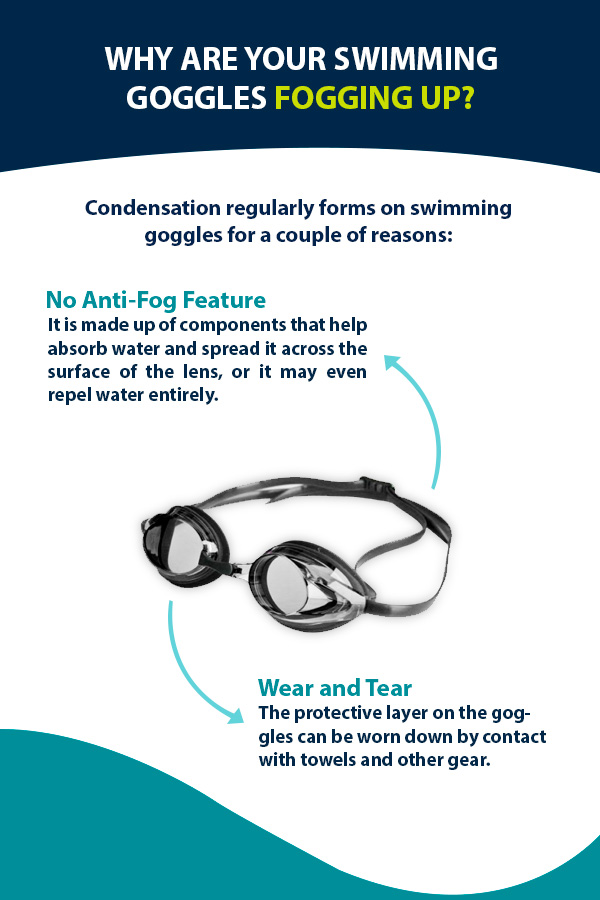
How Can You Prevent Foggy Goggles?
Your goggles are crucial to your ability to see well while you swim, whether your face is in or out of the water. Here are some ways to keep your swim goggles from fogging up:1. Anti-Fog Spray
While DIY methods can do the trick, some swimmers prefer to go with an option specifically designed for swim goggles. Anti-fog spray comes in a small bottle you can keep inside your swim bag. Some bottles have a carrying case that can be attached to the strap of your bag as well for easy access. The spray works by decreasing surface tension, which means it is more difficult for water droplets to gather and condense on your goggles. The hands-off application of anti-fog spray is one of its key benefits — since it's easy to scratch your lenses if you touch them with your fingers or a cloth that's too rough. Application of anti-fog spray is quick and simple. First, make sure each lens is clean. You do not want to mix the spray with any dirt or debris, such as sand. Next, use the spray bottle to apply a thin, even coat of the product to the inside of each lens. After spraying the goggles, give them a quick rinse. You can do this in the sink, shower or even the pool. Now your goggles should be clear for your workout or your race. You also have the option of leaving anti-fog spray on your goggles overnight. Apply the spray, rinse the goggles and then let them air dry while you sleep. They will be ready to go next time you head to the pool.2. Proper Care
If you want to stop swimming goggles from fogging up, proper care is the first line of defense. It will ensure the anti-fog layer on the lenses, as well as the rest of the goggles, lasts as long as possible. First, never to use your fingers to wipe off the inside of the lenses. If you need to clean your goggles while you swim, run them through the water in the pool. After you are done swimming, you can rinse them off with cool, fresh water in the sink. Rinsing the goggles off will remove chlorine and any other pool chemicals that can cause them to degrade. Before storing them, make sure they are completely dry to prevent mildew and mold growth, and avoid using any sort of abrasive material to dry them off. Rough material can scratch the protective anti-fog coating and make the goggles more vulnerable to fogging. Air drying is the safest drying method. Simply hang your goggles up and store them after they are completely dry. If you want to be extra vigilant about the longevity of your goggles, consider storing them in a protective case. It can protect the goggles from accidental scratches and keep the anti-fog layer intact for longer — which can be especially helpful if you have a more expensive pair of swimming goggles.3. Get Your Face Wet
Condensation can form due to the reaction between the cold pool water and your body heat. Swimmers can combat this issue by cooling down their face before entering the water. Splash your face with the cold pool water and then put on your goggles. Your skin will be cooler when you first dive in, and your goggles will not immediately fog up. This solution may only be temporary, though. As you push your body to swim faster, you will likely heat up, which could still cause fogging to occur.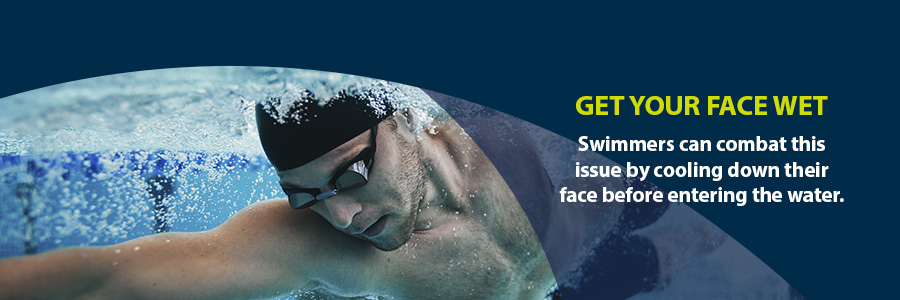
4. Spit Into Your Goggles
You have probably seen professional swimmers spit into their goggles before race time. While this might seem strange, it is actually an effective way to keep your goggles fog-free. Spit onto each lens and shake the goggles to make sure they are evenly coated. The saliva adds a thin layer of moisture to the lenses, which deters condensation. Some swimmers actually prefer this method because it means there is nothing there that could potentially cause eye sensitivity. Like wetting your face, spitting in your goggles is a temporary way to deal with the problem. You can use this method as often as you want, but you, of course, cannot stop in the middle of a race to do it.5. Shampoo
Swimmers rinse off in the shower before and after each swim, so shampoo is always handy. Just like toothpaste, shampoo can leave a thin protective film on your goggles that will prevent the formation of fog. Take a very small drop of shampoo and gently rub it across the surface of one lens. Repeat the process with the second lens. Then, rinse the goggles off in the sink or the shower. Just don't rinse them too much, or the shampoo will come off completely. Hair conditioner will also have the same effect. This method can certainly be effective, but you will want to keep your eyes safe. Everyone knows how much it burns when you accidentally get shampoo in your eyes. Opting to use baby shampoo is an ideal way to make sure this does not happen. The gentle formula is designed not to sting if you get it in your eyes. Whether you use baby shampoo or your regular shampoo, it is a good idea to test out this fog-free method for the first time during a practice session. That way, you can perfect the amount of shampoo and rinsing necessary to keep your goggles fog-free without causing eye sensitivity. You do not want to find out you didn't rinse your goggles off thoroughly enough on an important race day.6. Shaving Cream
Shaving cream is another quick and easy anti-fog option. If you already use shaving cream, grab a bottle from the cabinet or buy a small one to keep with you in your swim bag. Although it's thicker than toothpaste and shampoo, shaving cream has the same effect. Squirt a small amount onto your fingertip and gently smooth it across the inside of each goggle lens. If you have a soft towel that will not scratch up the lens, you can gently wipe the excess shaving cream away. Otherwise, you can quickly rinse off the goggles in the sink or the shower. Just like the toothpaste and shampoo tricks, keep eye sensitivity in mind. Make sure only a thin, transparent layer of the shaving cream is left behind. You should not actually be able to see anything on the surface of the lens. It may also be helpful to use shaving cream without a heavy scent. Unscented shaving cream for sensitive skin is a good option to reduce the risk of it affecting your eyes.
Turn to Kiefer for Top Quality Swim Gear
Like any piece of sports equipment, swimming goggles have a lifespan. If these tips to keep your goggles fog-free are no longer working, it may be time to invest in a new pair. When you are goggle shopping, you can look for options that specifically feature an anti-fog layer on the lenses. Brands like Speedo, RISE, TYR, Arena and Dolfin make goggles with anti-fog lenses. Keep in mind that durability, comfort, fit and price are also important factors to consider. No matter your style, color, brand and budget preferences, Kiefer's extensive collection of swim goggles will have what you need to dive into the pool with a fresh outlook. Forget about fog and focus on getting your new personal best, one stroke at a time. Shop Swim Goggles




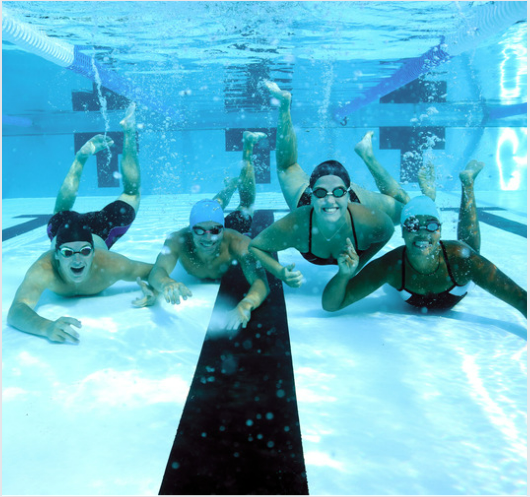


Leave a Comment
Your email address will not be published. Required fields are marked *